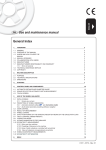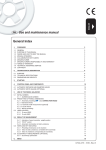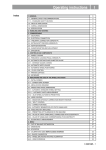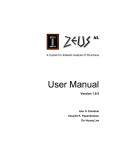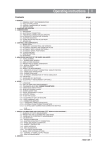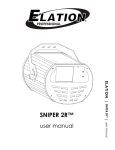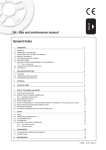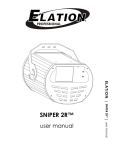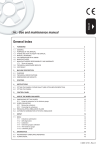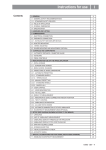Download I 0697 000 GB
Transcript
ENGLISH GB Use and maintenance manual General Index 1. FOREWORD 3 1.1 1.2 1.3 1.4 1.5 1.6 1.7 1.8 1.9 GENERAL PURPOSE OF THE MANUAL WHERE AND HOW TO KEEP THE MANUAL MANUAL UPGRADES COLLABORATION WITH USERS MANUFACTURER MANUFACTURER'S RESPONSIBILITY AND WARRANTY 1.7.1 Terms of warranty TECHNICAL ASSISTANCE SERVICE COPYRIGHT 3 3 3 3 4 4 4 4 5 5 2. MACHINE DESCRIPTION 6 2.1 2.2 2.3 PURPOSE TECHNICAL SPECIFICATIONS DIMENSIONS AND WEIGHTS 6 6 6 3. STARTING 7 4. CONTROL PANEL AND COMPONENTS 8 4.1 AUTOMATIC DISTANCE AND DIAMETER GAUGE 8 5 USE OF THE WHEEL BALANCER 9 5.1 5.6 INITIAL SCREEN 5.1.1 SCREEN-SAVE SCREEN PRESETTING OF WHEEL DIMENSIONS 5.2.1 Automatic presetting ( also CORRECTION MODE) 5.2.1.1 Standard wheels 5.2.1.2 ALUS wheels 5.2.2 Manual presetting USER CONTROL 5.3.1 To save USER 5.3.2 To call USER RESULT OF MEASUREMENT 5.4.1 Indication of exact correction weight position 5.4.2 “SPLIT” control 5.4.3 Automatic minimization of static unbalance WHEN AND WHY MATCHING 5.5.1 Presetting of tolerance on the machine 5.5.2 Value of static unbalance, correlated with eccentricity 5.5.3 Value of unbalance corresponding to eccentricity ECCENTRICITY MEASUREMENT (OPTIONAL) 9 9 9 9 9 10 11 11 11 11 12 12 13 13 14 15 15 15 15 6. MENU 16 5.2 5.3 5.4 5.5 I 0697 - 04/11 - Rev. 01 6.1 6.2 MENU ACCESS DIAGRAM UNBALANCE OPTIMIZATION 16 17 7. SETUP 17 7.1 7.2 7.3 7.4 7.5 7.6 7.7 7.8 7.9 LANGUAGE UNIT OF UNBALANCE MEASUREMENT UNBALANCE DISPLAY PITCH UNBALANCE DISPLAY THRESHOLD FOR TRUCK/CAR UNBALANCE DISPLAY PITCH FOR TRUCK/CAR SPIN WITH GUARD CLOSED SCREEN-SAVER TIME VISUAL ECCENTRICITY CHECK ACOUSTIC SIGNAL 17 17 17 17 17 18 18 18 18 8. SPECIAL CALIBRATIONS AND FUNCTIONS 19 8.1 8.2 8.3 8.4 CONTROL OF ECCENTRICITY MEASUREMENT PRESETTING THE CUSTOMER AND USER NAME CALIBRATIONS 8.3.1 Gauge calibration 8.3.1.1 Distance gauge calibration 8.3.1.2 Diameter gauge calibration 8.3.2 Balancing machine calibration WHEEL BALANCING MACHINE SELF TEST 19 19 19 19 19 19 19 19 9. DIAGNOSTICS 20 10. MAINTENANCE 22 10.1 GENERAL 10.1.1 Introductory notes 10.1.2 Safety rules 10.1.3 Replacing fuses 10.1.4 To replace the driving pulley 22 22 22 22 22 11. 23 DISPOSAL 11.1 DISPOSING OF THE BALANCER 11.2 DISPOSING OF ELECTRONICS COMPONENTS 23 23 12. 23 SPARE PARTS 12.1 IDENTIFICATION AND ORDERING METHOD 23 13. 23 ATTACHED DOCUMENTATION Use and maintenance manual Rev. 04-2011 ENGLISH 1. Foreword 1.2 PURPOSE OF THE MANUAL This manual, and the installation manual, contains the instructions required to use the machine safely and carry out routine maintenance work. WARNING THIS MANUAL IS AN INTEGRAL PART OF THE INSTALLATION MANUAL WHICH SHOULD BE CONSULTED CONCERNING STARTING AND USING THE MACHINE SAFELY . 1.1 GENERAL The machine has been constructed in conformity with the current EC Directives and the technical standards implementing the requirements, as stated in the declaration of conformity issued by the manufacturer and attached to the manual. This publication, hereinafter simply referred to as ‘manual’, contains all the information required to safely use and service the machine referred to in the Declaration of Conformity. This appliance, hereinafter is generically referred to as ‘machine’. The manual addresses operators instructed on the precautions to take in relation to the presence of electric current and moving devices. This publication is intended for all ‘users’ who as far as within their competence need to and/or are obliged to give instructions to others or operate on the machine themselves. These persons can be identified as follows: - operators directly involved in transporting, storing, installing, using and servicing the machine from when it is put on the market until when it is scrapped; - direct private users. The original Italian text of this publication constitutes the only reference to resolve any interpretation controversies related to the translation into the European Community languages. This publication forms an integral part of the machine and must therefore be kept for future reference until final dismantling and scrapping of the machine. Any calibrations, adjustments and extraordinary maintenance operations are not considered in this document as they may only be performed by the service engineer who must work on the machine according to the technical and rated characteristics for which it was built. Though it is fundamental to read this manual, it cannot replace skilled technical staff who must be adequately trained beforehand. The foreseen use and configurations of the machine are the only ones allowed by the manufacturer; do not attempt to use the machine in a different way. Any other use or configuration must be agreed in advance with the manufacturer in writing and in this case an annex will be attached to this manual. For use, the user must also comply with the specific workplace legislation in force in the country where the machine is installed. The manual also refers to laws, directives, etc., that the user must know and consult in order to accomplish the goals that the manual sets out to achieve. 1.3 WHERE AND HOW TO KEEP THE MANUAL This manual (and relative attachments) must be kept in a safe and dry place and must always be available for consultation. Make a copy and keep it in the archive. When exchanging information with the manufacturer or the technical assistance staff authorised by the former, quote the rating plate information and the serial number of the machine. This manual must be kept for the entire lifetime of the machine, and if necessary (e.g.: damage making all or some of it illegible, etc.) the user must request another copy exclusively from the manufacturer, quoting the publication code indicated on the cover. 1.4 MANUAL UPGRADES This manual is an integral part of the machine and reflects the state of the art at the moment it was put on the market. The publication complies with the directives in force on that date; the manual cannot be considered inadequate Introduction 3 ENGLISH Use and maintenance manual Rev. 04-2011 as a result of regulatory updates or modifications to the machine. - Any manual upgrades that the manufacturer may see fit to send to users will become an integral part of the manual and must be kept together with it. - 1.5 - COLLABORATION WITH USERS - in this manual use of the machine by people who have not read and fully understood the contents of this manual; use in breach of specific regulations in force in the country of installation; modifications made to the machine, software and operating logic, unless authorised by the manufacturer in writing; unauthorised repairs; exceptional events. Transfer of the machine to a third party must also include this manual; failure to include the manual automatically invalidates all the rights of the purchaser, including the terms of warranty, where applicable. If the machine is transferred to a third party in a country with a different language from the one written in this manual, the original user shall provide a faithful translation of this manual in the language of country in which the machine will operate. The manufacturer will be pleased to provide its customers with any further information they may require and will consider proposals for improving this manual in order to more fully satisfy the requirements it was written for. In case of transfer of ownership of the machine, which must always be accompanied by the use and maintenance manual, the original user must inform the manufacturer of the name and address of the new user in order to allow it to send the new user any communications and/or updates deemed to be indispensable. 1.7.1 Terms of warranty This publication is the property of the Manufacturer and may not be fully or partly reproduced without prior written agreement. The Manufacturer guarantees the machines it manufacturers against all manufacturing or assembly faults for 12 (twelve) months from the date of collection or delivery. 1.6 The Manufacturer undertakes to replace or repair any part which it deems to be faulty free of charge at its factory, carriage paid. MANUFACTURER The machine identification data is indicated on the plate mounted on the machine. The plate below is shown for the sake of example. If a Manufacturer's repairman (or a person authorised by the same) is required to work at the user's facilities, the relative travel expenses and board and lodging shall be charged to the user. The free supply of parts under warranty is always subject to the faulty part being inspected by the manufacturer (or a person authorised by the same). The warranty is not extended following repairs or other work done to the machine. The warranty does not cover damage to the machine deriving from: 1.7 MANUFACTURER'S RESPONSIBILITY AND WARRANTY - In order to make use of the manufacturer's warranty, the user must scrupulously observe the precautions contained in the manual, in particular he must: - - - - never exceed the limits of use of the machine; always constantly and carefully clean and service the machine; have the machine used by people of proven capacity and attitude, adequately trained for the purpose. The warranty is invalidated in case of: - The manufacturer declines all direct and indirect liability caused by: - use of the machine in a different way from that indicated 4 transport; neglect; improper use and/or use not in compliance with the instructions in the operating manual incorrect electrical connections. repairs made by people who were not authorised by the manufacturer; modifications that were not authorised by the manufacturer; use of parts and/or equipment that were not supplied or approved by the manufacturer; removal or alteration of the machine identification plate. Introduction Use and maintenance manual Rev. 04-2011 TECHNICAL ASSISTANCE SERVICE ENGLISH 1.8 For technical assistance requirements, contact the Manufacturer or authorised Dealer directly, always quoting the model and serial number of the machine punched on the identification plate. 1.9 COPYRIGHT The information contained in this manual may not be disclosed to third parties. Partial or total duplication, unless authorised by the Manufacturer in writing, through photocopying, duplication or other systems, including electronic acquisition, is breach of copyright and can lead to prosecution. Introduction 5 ENGLISH Use and maintenance manual Rev. 04-2011 2. Machine description 2.1PURPOSE It is a wheel balancing machine for trucks, light commercial vehicles and cars. It features excellent performance and is equipped with a manual lift with sliding carriage which allows mounting wheels of up to 250 kg on the spindle and, when fitted on the balancing machine, must not interfere with any fixed part of the machine, excluding the shaft and support adaptor. The machine is supplied with equipment enabling the vast majority of car and truck wheels available on the market to be fitted. Other wheels with special dimensions, geometry and centring require special adaptors supplied on request. The wheel balancing machine can operate without guards since the balancing speed is only 100 rpm. It functions properly without having to fasten it to the floor with wheels weighing up to 160 kg; for heavier wheels, fasten it at the points indicated. Do not mount anything other than motorbike, car or truck tyres on the wheel balancer. 2 1 3 The main features include: ▪▪ machine settings menu ▪▪ optimisation of tyre and rim unbalance ▪▪ STATIC programme, ALUS; SPLIT; USER control; indication of exact correction weight position Self diagnostics; Self calibration ▪▪ automatic minimisation of static unbalance. 2.2 TECHNICAL SPECIFICATIONS The following data refers to the balancer in its standard configuration. Single-phase power supply 115 / 230 V 50/60 Hz Protection class IP 54 Max.power consumption 0,8 kW Balancing speed 100 min-1 (car) 70 min-1 (truck) Measurement uncertainty 1 gr. (car) 10 gr. (truck) Cycle time for wheel 8÷20 sec. Average noise < 70dB (A) Rim width setting range 1.5” ÷ 20” or 40 ÷ 510 mm Diameter setting range 10” ÷ 30” or 265 ÷ 765 mm Min/max. compressed air pressure 8 ÷ 10 kg/cm2 approx. 0.8 to 1 Mpa; 4 5 approx. 8 to 10 bar; approx. 115 to 145 psi. 6 Maximum wheel weight < 250 Kg. Machine weight 210 Kg. 2.3DIMENSIONS 1. 2. 3. 4. 5. 6. 6 CONTROL PANEL WEIGHT-TOOL HOLDER LOCK NUT AUTOMATIC GAUGE LIFT LIFT PEDAL Machine description Use and maintenance manual Rev. 04-2011 ENGLISH 3. Starting 7. This pedal controls ascent and descent of the lift integrated in the machine. The carriage is manually driven. WARNING BEFORE SWITCHING ON THE MACHINE , MAKE SURE THAT ALL THE CONNECTIONS DESCRIBED IN THE INSTALLATION CHAPTER HAVE BEEN MADE CORRECTLY . THE FOLLOWING OPERATIONS INVOLVE A POTENTIAL RISK FOR THE OPERATOR , GIVEN THE PRESENCE OF VOLTAGE ON THE EQUIPMENT . IN THE THE PERSONAL PROTECTIVE EQUIPMENT DESCRIBED INSTALLATION MANUAL MUST BE WORN AND WORK MUST BE DONE WITH DUE CARE AND ATTENTION . OPERATIONS MAY ONLY BE PERFORMED BY A SPECIALISED TECHNICIAN . 8. Position the wheel on the terminal with the inner part facing the balancer; Before powering the machine, carry out the following checks: 1. check that the balancing machine touches the floor at the three support points; 2. make sure that all the parts of the balancer are cor rectly connected and fixed; 3. make sure that the parameters (voltage and frequency) of the mains power supply are compatible with those indicated on the rating plate of the balancer; 4. make sure the power cable is correctly connected; 5. make sure the machine shaft and flange hole are clean. 9. Firmly attach the wheel to the balancer shaft using the lock nut. 10. At this point, you can read the tyre measurements and perform balancing. CAUTION ANY TRACES OF DIRT MAY AFFECT BALANCING ACCURACY . 6. To switch on the balancer press the switch on the left-hand side of the machine Starting 7 ENGLISH Use and maintenance manual Rev. 04-2011 4. Control panel and components FUNCTION KEYS: they directly select the function on screen Confirm Selection of special function Starts measuring cycle Stops machine cycle CAUTION PRESS NEVER USE THE COUNTERWEIGHT GRIPPERS OR OTHER POINTED OBJECTS ! THE TFT 4.1 THE BUTTONS WITH YOUR FINGERS . MONITOR IS NOT A TOUCH SCREEN TYPE . AUTOMATIC DISTANCE AND DIAMETER GAUGE This gauge allows measurement of the distance of the wheel from the machine and the wheel diameter at the point of application of the counterweight. It also allows correct positioning of the counterweights on the inside rim by using the specific function ( INDICATION OF EXACT CORRECTION WEIGHT POSITION ) which allows reading, on the monitor, the position used for the measurement within the rim (for calibration, see the corresponding section). 8 Control panel Use and maintenance manual Rev. 04-2011 The monitor shows several information and suggests various alternative ways of use to the operator. This is through various “screens”. 5.1 ENGLISH 5 Use of the wheel balancer 5.1.1 SCREEN-SAVE SCREEN Name of the wheel balancer’s owner. Can be preset via the monitor. INITIAL SCREEN 5.2 PRESETTING OF WHEEL DIMENSIONS 5.2.1 Automatic presetting ( also CORRECTION MODE) Buttons enabled: : main functions screen ( MENU ACCESS DIA- GRAM) : selecting static correction : balancing spin (see RESULT OF MEASUREMENT) Dimensions gauge: when extracted, the Dimensions screen is selected ( PRESETTING OF WHEEL DIMENSIONS). If the machine remains on the initial screen for a certain amount of time without being used, the system is automatically switched to a screen-save. Striking of any key, movement of the wheel of distance + diameter gauge will cause automatic switching from the screen-save menu to the initial screen. The screen appears upon removing the distance + diameter gauge. The “dimension acquired” message is indicated by the correction weight symbol, which changes from blue to red. 5.2.1.1 Standard wheels Using the special grip, move the end of the gauge againstthe rim in one of the positions A/B indicated in the figure. Use of the wheel balancer 9 Use and maintenance manual Rev. 04-2011 The other enabled buttons are: ENGLISH Pos A Select the type of weight to apply ( CORRECTION METHODS). User call/save control. Pos B b) Adhesive weight: in the position indicated below. Position of adhesive weights FI Set the nominal width, which is normally shown on the rim, or measure the width “b” with the caliper gauge provided. Return to initial frame. Launch balancing. 5.2.1.2 ALUS wheels INDICATION Always use the round part of the striker plate. Hold the gauge in position for at least 2 seconds. If the acoustic signal is enabled ( ACOUSTIC SIGNAL), the acquisition of the dimensions is accompanied by a “beep”. Set the distance+diameter gauge to the rest position: the current width value is displayed inside the tyre. After the measurement performed for the FI inner side, as indicated in the figure below, pull out the gauge again to store the data for the FE outer side; choose position A or B at your choice. Keep this position for at least 2 seconds. The counterweight symbols change colour. When the acoustic signal is enabled ( ACOUSTIC SIGNAL), the acquisition is accompanied by a “beep”. FI FE Position of adhesive weights After having detected the dimensions, use the key to indicate the type of correction selected for the inner side. The following buttons are enabled: Management of save user recall b Selection of clip or adhesive weight for inside. Only for automatic width option: The L.T. key (LIGHT TRUCK) used to improve the dimensional calibration of large diameter wheels such as off-road, trucks, wheels which protrude significan tly from the rim. Press the L.T. key, after distance measurement, immediately before 10 Use of the wheel balancer lowering the guard for Width Measurement. The option is disengaged at the end of current Width Measurement. b Selecting the manual dimension preset- a ting screen Return to initial screen. Balancing run. ENGLISH Use and maintenance manual Rev. 04-2011 d In the event of correction type other than standard (spring weight), follow the instructions on the screen for correct detection of dimensions. 5.2.2 Manual presetting 5.3 USER CONTROL Position of adhesive weights If necessary, the dimensions can be inserted or edited in manual mode as follows: ▪ press + ▪ press to select the dimension to be preset (red). press ▪ press ▪ press The wheel balancer can be used simultaneously by 4 different users who, through a simple sequence, can memorize their work condition and call it when needed. The users’ names can be memorized (PRESETTING THE CUSTOMER AND USER NAME). 5.3.1 To save USER / to preset the required value. ▪ Preset the dimensions correctly according to the proce dures already described in sections AUTOMATIC PRE SETTING. ▪ Press to change unit of measurement. to preset the dimensions for the ALUS correction mode Definition of dimensions for correction using spring weights: Preset the nominal diameter stamped d = DIAMETER: on the rim. b = WIDTH: Preset the nominal width indicated on the rim ( STANDARD WHEELS) . a = DISTANCE: Preset the distance of the inside of the wheel from the machine, after measuring it with relative gauge. Use of the wheel balancer ; the “MENU” window appears on the monitor. ▪ Press ; a window appears with the list of availa ble USERS. The current user is displayed in red. ▪ Press the number corresponding to the required USER. The system returns to the initial screen automatically. 5.3.2 To call USER ▪ Perform a measuring spin with any dimensions. ▪ Press button the screen. ; the “MENU” window appears on 11 ENGLISH Use and maintenance manual Rev. 04-2011 ▪ ▪ Press : a window appears with the list of avai lable USERS. The current user is displayed in red. Press the number corresponding to the required USER. The system automatically returns to the initial screen with recalculation of the unbalance values on the basis of the effective dimensions of the USER called. INDICATION The dimensions memorized as USER are lost when the machine is switched off. The USER control is also valid for the ALUS dimensions. The current USER is always displayed in the Measurements and Dimensions screens. 5.4 RESULT OF MEASUREMENT ment, press push button [4] again for more than 1.5 seconds. Every time the machine is switched on, the status of eccentricity measurement reflects the settings in SPECIAL FUNCTIONS. Split control for splitting of unbalance over preset table components (“SPLIT” CONTROL). Button only enabled in STATIC or ALUS correction. Indication of the longitudinal position of the unbalance (INDICATION OF EXACT CORRECTION WEIGHT POSITION) is enabled. For selection of special functions Balancing spin. INDICATION If the machine remains on this screen without being used for more than the time preset in the Setup parameters, the screen automatically returns to the screen-save. 5.4.1 Indication of exact correction weight position After performing a balancing spin, the unbalance values are displayed as well as arrows useful for positioning the point of application of the correction weight. After positioning of the wheel, apply the weight in the 12 o’clock position. When the beep signal is enabled ( ACOUSTIC SIGNAL), reaching of the correction position is accompanied by a “beep”. If the wheel clamp option is enabled ( WHEEL LOCKING),the wheel is automatically clamped in the correction position. If the unbalance is less than the chosen threshold value, the “OK” appears instead of the unbalance value to indicate, on that particular side, the wheel is in tolerance; the resi-dual unbalance can be displayed by pressing button with an accuracy of 0.5 g (0.1 oz). The following buttons are enabled: Display of residual unbalance Selection of correction mode (STATIC/DUAL SURFACE). When the mode is changed, the unbalance values are recalculated automatically on the basis of the previous spin. When this push button is held down for more than 1.5 seconds, eccentricity measurement is temporarily disenabled (enabled in SPECIAL FUNCTIONS). To re-enable eccentricity measure 12 It is possible use this function in the event of correction of the external side using an adhesive weight placed inside the rim. Remember to thoroughly clean the application areas. This function allows cancelling approximations in the mounting of counterweights with consequent reduction of the residual unbalance. From the measurement results frame: ▪ Press button from the Measurements screen. ▪ Pull out the rim distance+diameter gauge in position A, figure in STANDARD WHEELS. Approach of the weight to the correction position is indicated by a moving coloured arrow [ ]. ▪ When a fixed arrow [ ] is reached, rotate the wheel to correction position (FI or FE) and apply the counterweight by turning the tip of the gauge towards the outside, into the position in which the pincers touches the wheel. Compensation is made for the fact that the weight application position is no longer at 12 o’clock (where appro- Use of the wheel balancer priate use the weight pusher). Turn the wheel in reverse direction of rotation. INDICATION when the acoustic signal is enabled ( ACOUSTIC SIGNAL), the reaching of a fixed arrow [ ] is accompanied by a “beep”. FI FE 4. At this stage, the screen shows the graphic display of the correction spokes with the relative weight of the unbalance detected. 5. Position the spokes indicated on screen in the 12 o’clock position and correct with the value displayed. Any error in this procedure is clearly shown on screen. Always follow the information provided by the wheel to optimise correction. When SPLIT is enabled, the icon on the left of the screen. 5.4.2 “SPLIT” control SPLIT is only possible in the event of static unbalance or ALUS external side and is used to hide any adhesive weights correcting unbalance behind the rim spokes. appears 5.4.3 Automatic minimization of static unbalance Initial unbalance sx dx g g phase shift 50° Possible approximations sx residual static4 To split the unbalance detected in two different positions, proceed as follows : 1. Position static unbalance or ALUS external side in the correction position : sx dx g g g sx dx sx dx g g g residual static3 g residual static g 1g dx g residual static6 With conventional Choice with minimum wheel balancer static residual g g This program is designed to improve the quality of balancing without any mental effort or loss of time by the operator. In fact by using the normal commercially available weights, with pitch of 5 in every 5 g, and by applying the two counterweights which a conventional wheel balancer rounds to the nearest value, there could be a residual static unbalance of up to 4 g. The damage of such approximation is emphasized by the fact that static unbalance is cause of most of disturbances on the vehicle. This new function, resident in the machine, automatically indicates the optimum entity of the weights to be applied by approximating them in an “intelligent” way according to their position in order to minimize residual static unbalance. 2. Select a spoke close to the 12 o’clock postion to be corrected, more it into the 12 o’clock position and press button [6]. 3. Turn the wheel in the rotation direction indicated on the unbalance display, brining the second spoke to the 12 o’clock position and press button [6]. Turn the wheel in direction of rotation. Use of the wheel balancer 13 ENGLISH Use and maintenance manual Rev. 04-2011 Use and maintenance manual Rev. 04-2011 ENGLISH 5.5 WHEN AND WHY MATCHING The software associated with eccentricity measurement is a powerful tool for determining the need to perform relative rotation between the rim and tyre in order to reduce the eccentricity of the wheel down to acceptable limits. The principle adopted is based on the consideration that a rim with acceptable tolerance, mounted with an acceptable tyre, can statistically generate a total eccentricity which is not acceptable but can be improved by matching. Generally speaking, rim measurement is not necessary, accurate or useful because: ▪ To measure the rim it is necessary to remove the tyre. There can by coarse errors on the outside (e.g. aluminium wheels!) ▪ The two rim sides can be eccentric in a very different way. Therefore to which one to make reference? What is the effect on the tyre mounted? ▪ To improve the eccentricity of a wheel, the rim should be eccentric, to compensate the tyre. And viceversa. ▪ If after a rotation by 180° of a wheel, the value is still out-of-tolerance, either the tyre or rim are too eccentric: One of the two must be replaced! wheel Ideal wheel rim tyre rotation axle Rim + 0.8 mm Tyre - 0.6 mm Wheel + 0.3 mm Eccentricity of the single items has been compensated. Example 1 The wheel is acceptable. wheel Example 3 rim wheel Ideal wheel Ideal wheel rim Example 2 tyre tyre rotation axle rotation axle Rim + 0.8 mm Tyre + 0.6 mm Rim 0 mm Wheel + 1.3 mm Tyre + 1.2 mm Eccentricity of the wheel is excessive, due to an acceptable rim or tyre but randomly placed in an “unfortunate” relative position. Wheel + 1,2 mm SOLUTION: Rotate the tyre on the rim by 180° RESULT: wheel eccentricity 0.3 - 0.4 mm (in tolerance) 14 Eccentricity of the wheel cannot be compensated by the rotation because the rim is perfect! SOLUTION: Rotate the tyre on the rim by 180° RESULT: no improvement is obtained. Use of the wheel balancer Use and maintenance manual Rev. 04-2011 ENGLISH 5.5.1 Presetting of tolerance on the machine There is no general rule concerning acceptability of an eccentricity value . As a first approximation we consider it correct to use a threshold of 1 to 1.5 mm. The E/ECE/324 standard prescribes 1.5 mm as max. eccentricity of a rebuilt tyre. 5.5.2 Value of static unbalance, correlated with eccentricity Clear indication is given in the Measurement screen of both the value and position of the static unbalance as well as the eccentricity. In fact, it is interesting to check the correlations of the two values, above all of the two positions. When the two positions have a similar angle (± 30° one from the other), there is a clear sign that an eccentricity is present which can be compensated by matching. 5.5.3 Value of unbalance corresponding to eccentricity For user’s reference, the centrifugal force is calculated corresponding to a certain speed, compared to the force generated by the eccentricity present on the tyre (calculated with an approximate average elastic constant). 5.6 ECCENTRICITY MEASUREMENT (OPTIONAL) The much enlarged figures show the outer tyre surface and axis of wheel rotation. A B GRAPH 1 (yellow) : represents the actual Peak-to-Peak eccentri-city. GRAPH 2 (red) : represents the eccentricity of the 1st harmonic. For a wheel in optimum conditions, such graph should approach a straight line. While rotating the wheel, the screen cursor indicates the current value, with the stage referred to the eccentricity measurement sensor. The following buttons are enabled: Start an eccentricity optimisation procedure (see ECCENTRICITY OPTIMISATION). A box is displayed indicating the offset effect that that eccentricity of the first harmonic measured may have, at an average speed of 120 Km/h. Return to measurement screen. Fig. A - shows measurement of the total Peak-to-Peak eccentricity defined as maximum radial deviation of the tyre surface. Fig. B - shows measurement of the eccentricity of the 1st harmonic, i.e. the eccentricity of that circle which “recopies” the tyre shape, by averaging the local deviations of the tyre from the round shape. Obviously the P.P. measurement is normally greater than that of the 1st harmonic. Tyre manufacturers normally supply two different tolerances for the two eccentricities. At the end of the balancing spin it is possible to automatically measure the eccentricity of the tyre through the SONAR sensor installed on the guard. The sensor should be positioned by hand in front of the tyre tread. Use of the wheel balancer 15 ENGLISH Use and maintenance manual Rev. 04-2011 6. Menu 6.1 MENU ACCESS DIAGRAM ▪ The symbol indicates the presence of a further menu. ▪ To return to the previous menu, press button ▪ To return to the initial screen, press button A User control B H C PASSWORD : + + + FOR SPECIALIZED PERSONNEL ONLY D User control E 16 Menu Use and maintenance manual Rev. 04-2011 UNBALANCE OPTIMIZATION 7. Setup ENGLISH 6.2 The Setup screen provides the user with many possibilities required for presetting the machine according to his own requirements. Such settings remain unaltered even when the machine is switched off. The following buttons are enabled: : return to previous window : return to Measurement screen The symbol is displayed automatically for static unbalance exceeding 30 grams (1.1 oz). The program allows reducing the total unbalance of the wheel by compensating, when possible, the unbalance of the tyre with that of the rim. It requires two spins with rotation of the tyre on the rim in the second spin. Press + after a first spin and follow the instructions appearing on the monitor. from 7.1 to : for selection of the parameter. LANGUAGE This function allows selecting the language to be used for displaying descriptive and diagnostic messages regarding machine operation. 7.2 UNIT OF UNBALANCE MEASUREMENT It is possible to select whether to display the unbalance values expressed in grams or ounces. 7.3 UNBALANCE DISPLAY PITCH This represents the display pitch of the unbalance and varies according to the unit of measurement selected. The selection “5 g” (1/4 oz) enables display of the correction values on both sides such as to bring the static unbalance to 0 (theoretical). It is recommended to preset this function as standard use of the machine as it improves the balancing quality. The computer makes a complex calculation which allows cancelling the residual static unbalance by varying the value and position of the counterweights fixed in steps of 5 grams (1/4 oz). 7.4 UNBALANCE DISPLAY THRESHOLD FOR TRUCK/CAR This consists of the unbalance threshold below which the wording “OK” appears on the screen at the end of the spin instead of the unbalance; the presettable values vary according to the unit of measurement selected. 7.5 UNBALANCE DISPLAY PITCH FOR TRUCK/CAR This represents the display pitch of the unbalance and varies according to the unit of measurement selected. The selection “5 g” (1/4 oz) for cars and of “50 grams” (1.0 oz.) for trucks.enables display of the correction values on both sides such as to bring the static unbalance to 0 (theoretical). It is recommended to preset this function as standard use of the machine as it improves the balanSetup 17 ENGLISH Use and maintenance manual Rev. 04-2011 cing quality. The computer makes a complex calculation which allows cancelling the residual static unbalance by varying the value and position of the counterweights of fixed value. 7.6 SPIN WITH GUARD CLOSED When “ON” is selected the automatic start of the spin is enabled when the guard is closed. 7.7 SCREEN-SAVER TIME If this function is enabled, the screensaver will automatically be activated when the machine is not used for a certain period of time. This function can be disabled by setting it to 0. 7.8 VISUAL ECCENTRICITY CHECK At the end of wheel acceleration, as soon as the motor is disengaged, the guard can be opened for visual control of any wheel eccentricity as the rotation speed gradually drops. Do not strike the wheel during the entire deceleration stage; to brake the wheel, close the guard. However, avoid using the brake as far as possible because this may compromise unbalance measurements. The unbalance values measured are only displayed when the wheel has come to a standstill. This function is active for only one machine run. 7.9 ACOUSTIC SIGNAL When “ON” is selected, the sending of an acoustic signal (beep) is enabled in the following cases: ▪ when any push button is pressed; ▪ when dimensions are acquired in automatic mode; ▪ when the correct angular position for weight application is reached in the Measurement screen; ▪ when the correct angular position for weight application is reached in the Position Repeater screen. 18 Setup Use and maintenance manual Rev. 04-2011 In order to gain access to the “Reserved Calibrations and functions” it is necessary to enter a password. Any incorrect operation within the functions described below could impair the operation of the wheel balancing machine. Unauthorized use will cause cancellation of the warranty on the machine. 8.1 CONTROL OF ECCENTRICITY MEASUREMENT 1. Set to ON/OFF to enable/disenable tyre eccentricity measurement when starting the unbalance measure ment 2. Set the phase shift angle between the eccentricity measurement sonar and the unbalance correction point (top vertical, 12.00 o’clock position) ENGLISH 8. Special calibrations and functions 8.3.1.2 Diameter gauge calibration To calibrate the diameter gauge, place it on the adapter flange and press . For better calibration turn the gauge downward and position it 40 mm away from the adapter plane. On the screen a value is shown near the word POS: if it is 256+/- 3°, set the gauge to rest position, otherwise press . to cancel the diameter gauge calibration function if it has erroneously been accessed. 8.3.2 Balancing machine calibration Recommended values: sonar mounted on the guard = 72°. To calibrate the balancing machine, use a wheel with steel rim of average dimensions, e.g. 6” x 14” (±1”). 8.2 To properly perform the procedure: ▪ Mount a wheel on the machine, even unbalanced, and very carefully set its dimensions. PRESETTING THE CUSTOMER AND USER NAME The machine can be customized by presetting: a) The name appearing on the Initial screen (screen-save). b) The name of 4 different machine users (USER NAME). An “ideal” keyboard appears on the monitor with the set of characters available for composition of the wordings. The Customer’s name consists of three lines, each max. 30 characters. The USER NAME consists of a wording max. 15 characters. 8.3 When CALIBRATIONS is pressed from the Special Functions menu, INDICATION Setting incorrect measurements will result in the machine not being correctly calibrated, and balancing of subsequent wheels will hence be incorrect until the machine is recalibrated with the correct measurements!! ▪ Follow the on-screen instructions. 8.4 WHEEL BALANCING MACHINE SELF TEST An automatic self-diagnostic cycle is provided for easier trouble-shooting ( Consult the extraordinary maintenance manual or contact Technical Service). access is gained to the Calibration menu. 8.3.1 Gauge calibration 8.3.1.1 Distance gauge calibration To calibrate the distance gauge, set it in rest position and then on the adapter plane. When done, set the gauge in rest position. If calibration is correct, the wheel balancer is ready for operation, otherwise an error message may be displayed if there are errors or malfunctioning; in this case repeat calibration. to cancel the distance gauge calibration function if has erroneously been accessed. Special calibrations and functions 19 ENGLISH Use and maintenance manual Rev. 04-2011 9. Diagnostics WARNING THE INFORMATION IN THE ISED PEOPLE WHO MUST POSSIBLE REMEDY COLUMN REQUIRES WORK TO BE PERFORMED BY SPECIALIST TECHNICIANS OR OTHER AUTHORALWAYS WORK USING THE P ERSONAL P ROTECTIVE E QUIPMENT INDICATED IN THE INSTALLATION MANUAL . I N SOME CASES , THIS WORK CAN BE PERFORMED BY A NORMAL OPERATOR . ERRORS CAUSES CONTROLS Black The wheel balancer does not switch on. 1. 2. 3. 4. Verify correct connection to the mains. Verify and eventually replace the fuses on the power card. Verify monitor function. Replace the computer board. Err. 1 No rotation signal. 1. 2. 3. Check in self-diagnostics that the encoder functions properly. Replace the phase pick-up board. Replace the computer board. Err. 2 Speed too low during detection. During unbalance measurement rotation, wheel speed is less than 42 rpm. 1. 2. 3. Make sure that a vehicle wheel is mounted on the wheel balancer. Check in self-diagnostics that the encoder functions properly Disconnect the piezo connectors from the board and do a spin (if no error is detected, replace the piezo sensors). Replace the computer board. Err. 3 Unbalance too high. 1. 2. 3. 4. 5. Verify wheel dimension settings. Check detection unit connections. Perform machine calibration. Mount a wheel with more or less known unbalance (less than 100 grammes) and verify the response of the machine. Replace the computer board. Err. 4 Rotation in opposite direction. After pressing [START], the wheel starts turning in the opposite direction (anticlockwise). 1. 2. Check in self-diagnostics that the encoder functions properly Check the bearing/spring of the phase generator Err. 5 Guard open The [START] pushbutton was pressed without first closing the guard. 1. 2. 3. 4. Reset the error by pressing pushbutton [7]=End. Close the guard. Verify the function of the protection uSwitch. Press the [START] pushbutton. Err. 7 / Err. 8 NOVRAM parameter read error 1. 2. 3. 4. 5. Repeat machine calibration Shut down the machine. Wait for a minimum time of ~ 1 Min. Re-start the machine and verify correct operation. Replace the computer board. Err. 9 NOVRAM parameter write error. Replace the computer board. Err. 11 Speed too high error. During unbalance measurement rotation, wheel speed is more than 270 rpm. 1. 2. 3. Check if there is any damage or dirt on the timing disc. Check in self-diagnostics that the encoder functions properly. Replace the computer board. Err. 12 Unbalance measuring cycle error. 1. 2. 3. Check in self-diagnostics that the encoder functions properly Verify correct motor operation. Replace the computer board. Err.13/ Err.14/ Err.15/ Err.16/ Err.17/ Err.18 Unbalance measurement error. 1. 2. 3. 4. Check in self-diagnostics that the encoder functions properly Check detection unit connections. Verify machine earth/ground connection. Mount a wheel with more or less known unbalance (less than 100 grammes) and verify the response of the machine. Replace the computer board. 4. 20 5. Diagnostics Err. 22 Maximum number of spins possible for the unbalance measurement has been exceeded. 1. Check that a vehicle wheel has been mounted on the wheel balancer. 2. Check in self-diagnostics that the encoder functions properly 3. Replace the computer board. Err.40/ Err.41/ Err.42/ Err.43 Eccentricity graph plotting procedure error. Perform a new eccentricity measurement. Err.45/ Err.46/ Err.47/ Err.48 Eccentricity graph value display readout error. Perform a new eccentricity measurement. Err.50/ Err.51/ Err.52/ Err.53 Eccentricity graph current value cursor plotting procedure error. Perform a new eccentricity measurement. Err.54 Sonar readout error. Sonar value readout impossible. 1. 2. 3. 4. 5. 6. Err.55 Sonar readout error. Sonar values are insufficient for correct measurement of eccentricity. 1. 2. 3. Diagnostics ENGLISH Use and maintenance manual Rev. 04-2011 Position the eccentricity measurement sonar correctly before performing the measurement. Check eccentricity sonar connections. Check the power supplies on the power board. Replace the eccentricity measurement sonar. Make sure that the wheel does not halt before completing at least 4/5 revolutions after the first braking impulse. Replace the computer board. Position the eccentricity measurement sonar correctly before performing the measurement. Make sure that the wheel does not halt before completing at least 4/5 revolutions after the first braking impulse. Mount a wheel of medium dimensions (14”x5 ¾”) and perform an eccentricity measurement . If in these conditions error 55 no longer occurs, this means that the wheel inertia causing the problem is such as to half the wheel before having acquired the minimum number of values necessary for reliable eccentricity measurement. 21 ENGLISH Use and maintenance manual Rev. 04-2011 10. 10.1 Maintenance GENERAL Specialist staff must be authorised and especially trained concerning the dangers that may arise during operation and the correct methods for avoiding them. They must always work with great care and pay full attention. CAUTION BEFORE PERFORMING ANY MAINTENANCE OPERATIONS, MAKE SURE If, exceptionally, the staff removes the guards to carry out a particular specialist technical maintenance, inspection or repair job, they are required to put them back after work. THE MACHINE HAS BEEN DISCONNECTED FROM THE MAINS POWER SUPPLY . ALWAYS USE THE PERSONAL PROTECTIVE EQUIPMENT MANUAL. INDICATED IN THE I NSTALLATION 10.1.1 Introductory notes This machine has been designed so as not to require routine maintenance, apart from accurate periodic cleaning. It is important to keep the machine perfectly clean in order to prevent dust or impurities from compromising the operation of the balancer. After work, staff must make sure that foreign objects, in particular mechanical pieces, tools or devices used during the operative procedure that could cause damage or malfunctions are not left inside the balancer. For safety, before starting work, maintenance, inspection and repair staff must disconnect all power sources and take all the necessary preventive safety measures. As well as operating frequencies, the operations described below indicate the qualifications that staff must possess in order to perform the operation. 10.1.3 Replacing fuses WARNING THE PEOPLE RESPONSIBLE FOR CLEANING THE AREA WHERE THE MACHINE IS INSTALLED MUST WEAR PERSONAL PROTECTIVE EQUIPMENT IN ORDER TO WORK IN SAFETY AND ACCORDING TO THE CURRENT OCCUPATIONAL HEATH AND SAFETY REGULATIONS . As extraordinary maintenance must be performed by service staff or, in any case, by specifically authorised and trained people, is not dealt with in this manual. 10.1.2 Safety rules Performing specialist activities on the equipment, particularly if the guards need to be dismounted, exposes people to serious danger due to the presence of potentially live parts. Some protection fuses are located on the power board (see wiring diagrams) accessible by dismantling the weight shelf). If fuses require replacement, use ones with an identical current intensity. 10.1.4 To replace the driving pulley The drive pulley is guaranteed by the manufacturer for approximately 20000 runs. A spare pulley is found inside the base (see photograph). If necessary, to replace the pulley, proceed as follows: ▪ Remove the head and the weight holder shelf, taking care not to damage the electric wires ▪ Remove the retaining screw on the pulley in order to replace it. The rules shown below must be scrupulously followed. People must always use the Personal Protective Equipment indicated in the Installation Manual. During activities, unauthorised people may not access the equipment and WORK IN PROGRESS signs will be erected in the department in such a way that they are visible from every place of access. 22 Maintenance Use and maintenance manual Rev. 04-2011 12.1 ENGLISH 12. Spare parts 11. Disposal IDENTIFICATION AND ORDERING METHOD CAUTION THE INSTRUCTIONS IN THIS CHAPTER ARE INDICATIVE . REFER TO THE REGULATIONS IN FORCE IN THE COUNTRY WHERE THE EQUIP MENT IS USED . 11.1 DISPOSING OF THE BALANCER The balancer must be disposed of after dismounting the various parts. For disposal operations, as well as wearing the Personal Protective Equipment indicated in the INSTALLATION MANUAL, refer to the instructions and diagrams in this manual. If necessary, request specific information from the manufacturer. After dismounting the various parts, sort the various components, separating metal from plastic, from copper, etc., according to the sorted waste disposal regulations in force in the country in which the equipment is dismantled. If the various components must be stored before being taken to the dump, make sure to keep them in a safe place protected from atmospheric agents in order to prevent them from contaminating the ground and the water table. 11.2 DISPOSING OF ELECTRONICS COMPONENTS The various parts can be identified using the drawings and diagrams in the machine technical file which is archived by the Manufacturer to which a request can be made. For off-the-shelf parts, the technical manuals or the supplier's original documents can be provided if the Manufacturer deems this to be useful. If not supplied, this documentation is also included in the machine Technical File, archived by the Manufacturer, as regards by Ministerial Decree 98/37/EC. In this case, contact the Technical Service to identify the required piece. If the required pieces are not in any position or they cannot be identified, contact the Technical Service, specifying the type of machine, its serial number and year of construction. This information is indicated on the machine identification plate. 13. Attached documentation If not supplied, this documentation is included in the Technical File of the machine, archived by the Manufacturer. Community directive 2002/96/EC, assimilated in Italy with legislative decree n° 151 of 25th July 2005, requires electrical and electronic equipment manufacturers and users to comply with a number of obligations concerning the collection, treatment, recovery and disposal of this waste. In this case, contact the Technical Service for detailed information concerning the machine. Please scrupulously comply with these waste disposal regulations. Remember that abusive dumping of this waste leads to the application of the administrative penalties established by current law. Disposal – Spare parts – Attached documents 23
























